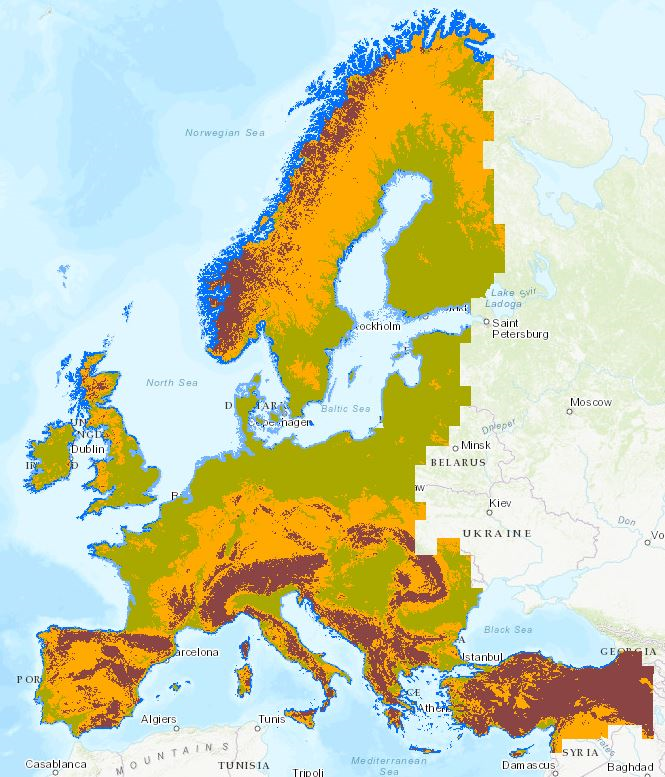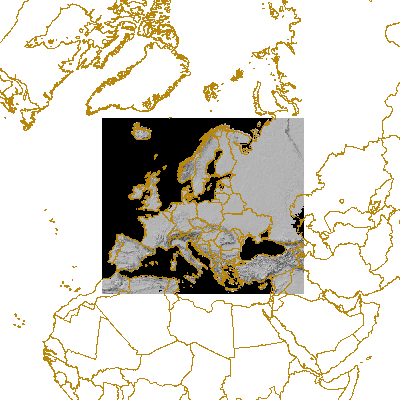Elevation
Type of resources
Available actions
Topics
INSPIRE themes
Keywords
Contact for the resource
Provided by
Years
Formats
Representation types
Update frequencies
status
Service types
Scale
Resolution
-
Contour lines 0.25 m equilibrium. The lines are derived from the Denmarks DEM and are calculated to give as many possible details as possible from the elevation model. The contour lines must be within an elevation deviation of +/- 0.125 m and furthermore the lines must not be moved more than a maximum of 0.4 meters in the plane.
-

This layer defines homogeneous areas as function of height, slope and distance to the sea. The Elevation Breakdown is used to allocate Land Cover Changes into homogeneous areas as function of height, slope and distance to the sea. It defines five relief typologies: 1) Low coasts, 2) High Coasts, 3) Inlands, 4) Uplands and 4) Mountains. The previous enumeration corresponds to values in the grid.This layer is an updated version using similar methodology to the one created on 2006 (same classes and thresholds) but it has been generated using up-to-date high resolution datasets (EU-DEM) in order to create a more accurate layer.
-
Web Map Service providing access to contour lines, spot elevation and grid coverage for elevation data in Denmark. National elevation data has been transformed to the INSPIRE EL vector GML application schema v4.0.
-

This is a cropped DTM version (with Frame2c) for providing topographic backgrouds on EEA maps. This is a hillshade of global digital elevation model (DEM) with a horizontal grid spacing of 30 arc seconds (approximately 1 kilometer).
-
DSM is collected by laser scanning from aircraft (LiDAR). The elevation model is constantly updated, approx. 1/5 a year. Data contains information about when an area has flown. The point cloud has an average density of 4-5 points / m2 for data collected in 2014/15 and 8 points / m2 for data from 2018 onwards. The point cloud is classified and only points located on surface form the basis for this dataset. The point cloud is converted into a grid with a size of 0.4 meters. Specifications: Horizontal 0.15 meters, Vertical 0.05 meters.
-
DTM is collected by laser scanning from aircraft (LiDAR). The elevation model is constantly updated, approx. 1/5 a year. Data contains information about when an area has flown. The point cloud has an average density of 4-5 points / m2 for data collected in 2014/15 and 8 points / m2 for data from 2018 onwards. The point cloud is classified and only points located on surface form the basis for this dataset. Buildings, vegetation and other objects have been removed from the model. The point cloud is converted into a grid with a size of 0.4 meters. Specifications: Horizontal 0.15 meters, Vertical 0.05 meters.
-

EuroGlobalMap is a topographic dataset that covers the EU (except Bulgaria), Andorra, Croatia, Faroe Islands, Greenland, Iceland, Liechtenstein, Moldova, Monaco, Norway, San Marino, Switzerland, Ukraine and Vatican at the scale 1:1 Million. It is produced in cooperation by the National Mapping Agencies of Europe, using official national databases. Thematic layers: administrative boundaries, hydrography, transportation, settlements, elevation points, named location. This metadata only refers to the coastline from EuroGlobalMap.
-

Generalisation at 1 km resolution of elevation breakdown 100 m (based on EU-DEM). This layer defines homogeneous areas as function of height, slope and distance to the sea. The Elevation Breakdown is used to allocate Land Cover Changes into homogeneous areas as function of height, slope and distance to the sea. It defines five relief typologies: 1) Low coasts, 2) High Coasts, 3) Inlands, 4) Uplands and 4) Mountains. The previous enumeration corresponds to values in the grid.This layer is an updated version using similar methodology to the one created on 2006 (same classes and thresholds) but it has been generated using up-to-date high resolution datasets (EU-DEM) in order to create a more accurate layer.
-

The EEA coastline for analysis is created for highly detailed analysis, e.g. 1:100 000, for geographical Europe. The coastline is a hybrid product obtained from projects using satellite imagery as data source: EUHYDRO [link not available - yet] and GSHHG [http://www.soest.hawaii.edu/pwessel/gshhg/]. The defining criteria was altitude level = 0 from EUDEM [will become available from EEA website]. Outside the coverage of the EUDEM, the coastline from GSHHG was used without modifications. A few manual amendments to the dataset were necessary to meet requirements from EU Nature Directives, Water Framework Directive and Marine Strategy Framework Directive. In 2015, several corrections were made in the Kalogeroi Islands (coordinates 38.169, 25.287) and two other greek little islets (coordinates 36.766264, 23.604318), as well as in the peninsula of Porkkala (around coordinates 59.99, 24.42).
-

The EEA coastline for analysis is created for highly detailed analysis, e.g. 1:100 000, for geographical Europe. The coastline is a hybrid product obtained from projects using satellite imagery as data source: EUHYDRO [link not available - yet] and GSHHG [http://www.soest.hawaii.edu/pwessel/gshhg/]. The defining criteria was altitude level = 0 from EUDEM [will become available from EEA website]. Outside the coverage of the EUDEM, the coastline from GSHHG was used without modifications. A few manual amendments to the dataset were necessary to meet requirements from EU Nature Directives, Water Framework Directive and Marine Strategy Framework Directive. In 2015, several corrections were made in the Kalogeroi Islands (coordinates 38.169, 25.287) and two other Greek little islets (coordinates 36.766264, 23.604318), as well as in the peninsula of Porkkala (around coordinates 59.99, 24.42). This dataset is a polygon usable as a water-land mask.
 RUC Geo-Data catalogue
RUC Geo-Data catalogue